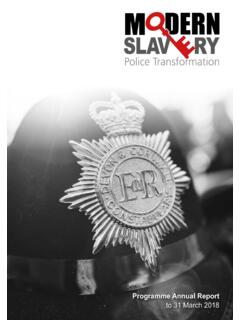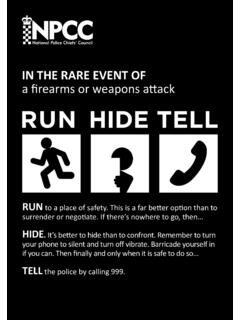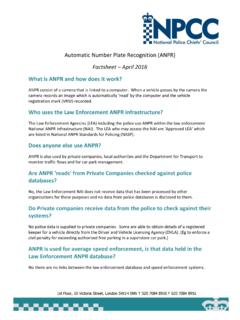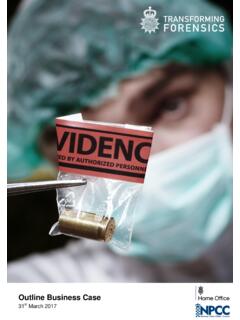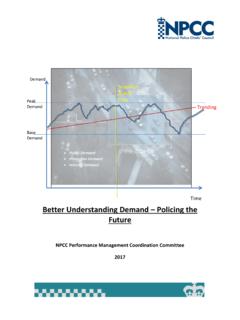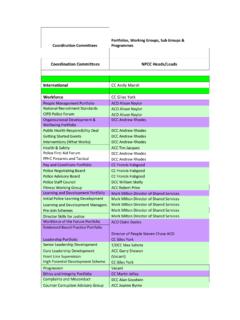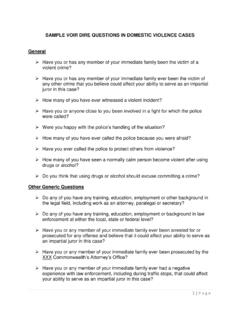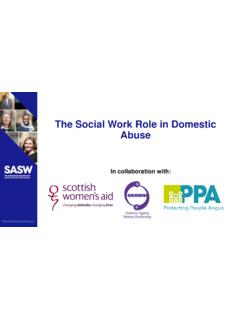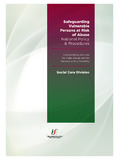Transcription of WHEN TO CALL THE POLICE - National Police Chiefs' Council
1 WHEN. TO CALL. THE POLICE . Guidance for schools & colleges INTRODUCTION. Who is this for? Chapter 1 of working together to safeguard children explains POLICE assistance is required that the safeguarding partners should publish a threshold This advice is for school and college staff with responsibility document that should include the criteria, including the level All other non-emergency incidents should be reported for behaviour management, including designated safeguarding of need, for when a case should be referred to local authority using 101 or online reporting methods, or through existing leads (DSLs), their deputies, head teachers and senior children 's social care for assessment arrangements, for example, to a safer schools officer. The call leadership teams in schools and colleges in England. and for statutory services under section 17 and 47 of the will be logged by an operator and depending on the nature of children 's Act 1989. the incident the appropriate response made.
2 What does this advice cover? Local authorities, with their partners, should develop and Contact with POLICE should ideally be made by a single point of This advice covers incidents on school and college premises publish local protocols for assessment. A local protocol should contact from the school. This may be the headteacher or the where students have potentially committed a crime. It provides set out clear arrangements for how cases will be managed once designated safeguarding lead. Every school and college should guidance on what schools and colleges should bear in mind a child is referred into local authority children 's social care. have a designated safeguarding lead who will provide support when considering contacting the POLICE . This advice covers the to staff to carry out their safeguarding duties and who will liaise following situations: Sexual offences closely with other services such as children 's social care. The designated safeguarding lead (and any deputies) are most likely Assault In the case of incidents involving sexual offences, schools and to have a complete picture of safeguarding and be the most Criminal damage colleges should refer to local safeguarding protocols, alongside appropriate person to advise on the response to safeguarding Cyber crime Keeping children safe in education and Sexual violence and concerns.
3 Drugs harassment between children in schools and colleges guidance. Harassment Having a single point of contact between a school or college Sexual offences In cases involving youth produced sexual imagery often called and the POLICE helps increase consistency in referrals. Theft sexting' - schools and college may refer to the non-statutory Weapons UKCCIS sexting in schools and colleges guidance. This advice aims to support schools and college to make What is the status of this advice? Contacting the POLICE defensible decisions when considering whether to involve the In an emergency dial 999. This should be used if: POLICE . This advice has been produced by the National POLICE Chiefs'. Council working alongside the Department for Education, - There is a danger to life or Safeguarding incidents Home Office and the PSHE Association. - Risk of serious injury or - A serious crime is in progress or about to happen. This advice does not cover safeguarding incidents. Where a This advice is non-statutory and should be read alongside child is suffering, or is likely to suffer from harm, it is important the Department for Education's (DfE) keeping children safe Any member of staff witnessing such an incident should that a referral to children 's social care (and if appropriate the in education statutory guidance and non-statutory searching, be empowered to dial 999 as they will be able to give POLICE ) is made immediately.
4 Referrals should follow the local Screening and Confiscation advice for schools. the most accurate account of the incident. referral process. 2. Making a decision to involve Any aggravating factors which contribute to making the Vulnerable young people the POLICE incident and subsequent level of harm more serious would be relevant in making a decision on whether or not to involve the All staff should be prepared to identify children and young When an incident occurs in which a crime has or may have POLICE . people who may benefit from early help. Early help means been committed, the school or college need to consider providing support as soon as a problem emerges at any point in whether to involve the POLICE . Many incidents can be dealt Ideally the decision as to whether the school or college deal a young person's life, from the foundation years through to the with and resolved internally. The school or college behaviour with an incident internally or pass it over to the POLICE needs teenage years.
5 Policy will give guidance on how to deal with and record such to be made at the initial stage, by gathering only enough incidents. information to establish the facts of the case. Some areas of vulnerability are highlighted below, but should not be seen as a comprehensive list. It's important to note that This guidance document outlines the factors which school or The school or college should be aware that they may not be most children and young people with vulnerabilities do not college leaders should consider when deciding to involve the aware of all circumstances leading to or connected to the commit offences. POLICE . These considerations would inform whether the POLICE incident students behaviour or involvement outside school would expect and need to be involved. or within their family. Contacting the POLICE or other agencies However, the challenges that children and young people may allow a further picture to be obtained, which assists in with vulnerabilities are facing can sometimes contribute All concerns, discussions and decisions made, and the reasons making informed decisions.
6 To behaviour which may lead them to unwittingly commit for those decisions, should be recorded in writing. If in doubt offences. about recording requirements, staff should discuss with the When the decision is made that the school or college will deal designated safeguarding lead (or deputy). with the incident internally, it remains the responsibility of the All school and college staff should be particularly alert to the school or college to investigate and resolve it in accordance potential need for early help for a child or young person who: Things to consider with their behaviour policy. Parental cooperation should be maintained throughout and the incident and actions recorded. is disabled and has specific additional needs In making a decision to involve the POLICE it is important that has special educational needs (whether or not they have a the school or college ensure a balance is struck between the The designated safeguarding lead (or a deputy) should be statutory education, health and care plan).
7 Needs of the students involved and the needs of other students leading the schools or college's response and should be aware is a young carer and the wider school or college community. of the local process for referrals to children 's social care and is showing signs of being drawn in to anti-social or criminal . making referrals to the POLICE . behaviour, including gang involvement and association It is not always clear initially who is involved in an incident with organised crime groups and in what capacity. The victim in any incident should be Schools and colleges should be aware that if a referral is made is frequently missing/goes missing from care or from home supported and protected as a priority. Those suspected of to children 's social care, this may result in a subsequent referral is at risk of modern slavery, trafficking or exploitation being the offender will also need to be supported. There will to the POLICE . is at risk of being radicalised or exploited often be significant circumstances in a young person's life that is in a family circumstance presenting challenges are contributing factors to an incident and it is important that Many schools and colleges have close relationships with their for the child, such as drug and alcohol misuse, they are taken into consideration.
8 Local POLICE force and many POLICE forces have a permanent or adult mental health issues and domestic abuse semi-permanent POLICE presence in schools and colleges. The is misusing drugs or alcohol themselves The seriousness of the incident will be a judgement call for the designated safeguarding lead (or deputy) should be liaising has returned home to their family from care school or college. In making this decision the level of harm and closely with the local POLICE when an incident in which a crime is a privately fostered child the circumstances leading to the incident would need to be may have been committed occurs. is a child in care carefully considered. has experienced recent trauma ie bereavement 3. Crimes reported to the POLICE In any incident where a crime may have occurred schools and An incident is considered a hate incident when the colleges should consider: victim or anyone else believes that the incident was When the decision is made to report an incident to the POLICE motivated by hostility or prejudice based on one of the for investigation, due to the seriousness of the incident or for The seriousness of the incident.
9 Whether an incident is following things: other aggravating circumstances, the school or college should serious' will be a matter of judgement and will depend on . cease their own investigation, having asked only enough the type of incident. disability questions to establish the basic facts of the incident. Every Whether there are any aggravating factors. These factors race effort should be made by the school or college to preserve any increase the level of risk, or highlight the need for a wider religion relevant evidence. investigation and the need for the involvement of a range transgender identity of agencies as well as the POLICE sexual orientation Initial enquiries undertaken by the school or college should be Whether the young people involved have any . fully documented as they may be required if the matter goes to vulnerabilities. If you believe something is a hate or prejudiced based incident court. This includes recording questions asked to young people Whether this could be part of a pattern of behaviour also it should be recorded as such by the person you are reporting and their replies.
10 Occurring in the community, in which case the POLICE will it to. All POLICE forces record hate incidents based on these five want to be involved. personal characteristics. Where a crime is reported to the POLICE , it will be recorded as a crime and an investigation will commence. The context of the offence is really important and the school When is a hate or prejudice or college are in the best position to gather together all the Whilst the age of criminal responsibility is ten, if the alleged relevant information prior to making a decision whether or not incident also a hate crime? perpetrator of a crime is under ten, it may still be necessary to to report to the POLICE . The decision and the rationale behind it involve the POLICE . The POLICE will take a welfare approach in should both be recorded. When hate incidents become criminal offences they are known these cases rather than a criminal justice approach. as hate crimes. Any criminal offence is a hate crime if it is What are hate or prejudice based motivated by hostility or prejudice based on disability, race, Arresting on school or college religion, transgender identity or sexual orientation.

